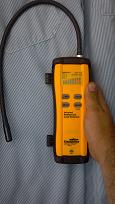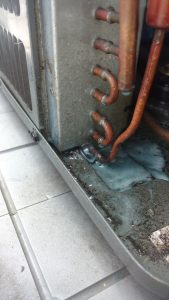 Hvac leak detection can be one of the hardest parts of being an Hvac Technician. Some refrigerant leaks will stand out at you, sometimes you can see traces of oil around the compressor, indicating a refrigerant leak, or sometimes you can smell the gas and pin point it from there. But what about those tiny leaks that only seem to grow over the years.
Hvac leak detection can be one of the hardest parts of being an Hvac Technician. Some refrigerant leaks will stand out at you, sometimes you can see traces of oil around the compressor, indicating a refrigerant leak, or sometimes you can smell the gas and pin point it from there. But what about those tiny leaks that only seem to grow over the years.
You could have purchased a new system 2 years ago, and it may have only lost a pound of refrigerant. That refrigerant leak could be getting bigger and bigger as the years go by, but you just keep paying to have refrigerant added to the system. 5 years go by and the refrigerant leak gets bigger, to the point that it will only hang on a couple days and freeze the system up, or damage the compressor, or whatever. Let’s say the freon leak was in the evaporator coil, over 5 years from installation, that coil is out of warranty. Now the customer, or YOU if you are the customer, have to fork over a heck of a lot more money to get it replaced.
6 Methods of HVAC Leak Detection
 I’m going to cover some of the methods that I use for refrigerant leak detection. I won’t be covering gas leaks as I don’t deal with that type of HVAC and don’t want to lead anyone in the wrong direction. These methods should only be performed by those that work in the HVAC field.
I’m going to cover some of the methods that I use for refrigerant leak detection. I won’t be covering gas leaks as I don’t deal with that type of HVAC and don’t want to lead anyone in the wrong direction. These methods should only be performed by those that work in the HVAC field.
There’s two reasons why we would be looking for a refrigerant leak on a HVAC systems
- When a system appears undercharged of refrigerant, when checked professionally by licensed HVAC technicians
- Whenever any refrigerant line, or component is open to the atmosphere – Hvac repairs and installation in the refrigerant cycle
#1 Test for Leaks with Dry Nitrogen
Leak detectors come out first when troubleshooting. But when making repairs that open the refrigeration system up, you may want to do a quick leak check by boosting the system up to 200psi or more. I do this before pulling a vacuum. This is a decent method for doing a quick leak check before pulling a vacuum.
#2 Evacuation Test with Vacuum Pump
Pull a vacuum on the HVAC refrigerant system to 500 microns or below. Valve off your gauges. Turn off the vacuum pump. Your micron gauge should never reach anywhere close to atmospheric pressure. A few hundred micron rise may be normal, but if your going up fast to the thousands then you probably have a leak.
#3 Refrigerant Leak Detectors
Leak Detection can get difficult, this is when it’s time to pull out your refrigerant leak detector. There are two types that I like to use and they are the heated diode type and the infrared type leak detector. Both work good, but remember if you are an air conditioning technician in training, don’t go cheap when buying a leak detector, you get what you pay for.
Infrared Leak Detectors
I like the Fieldpiece SRL2K7 Infrared Leak Detector. It gets great reviews from some of the professionals over at Hvac-Talk.com – Though this type of refrigerant leak detector is not for everyone, and can be a little tricky to use if you are used to using the heated diode type. The advantage of this type of technology is that the sensors will last about 10 years. They trigger on refrigerant concentration, so a sweeping motion must be used with this type of leak detector. The only disadvantages I have with infrared leak detectors is that they are more expensive. But then again you get what you pay for.
Heated Diode HVAC Leak Detectors
The most famous one and talked about the most is the H10. Works great on sniffing out R-22 and 134A refrigerant leaks. 410A not so much, especially is they are very, very small leaks. I have heard good things about the D-Tek leak detector though, which has been upgraded to detect 410A accurately. If I were to buy another refrigerant detector it would be the D-Tek just because most the guys I work with use it and love it.
#4 HVAC Dye Test
There are leaks that can occur in evaporator and condensing coils that just will not trigger on some leak detectors. Either that or they just take too long to find. One option that will save you time, and will 100% pinpoint your leak (unless line set is underground) is the dye leak detection test.
Dye kits will consist of dye cartridges, a UV flashlight and glasses. You basically inject the dye into the system while it is running, and let the dye cycle for a couple of days. Return with your UV flashlight and glasses and the dye will light up where the refrigerant leak is present.
One of the most efficient ways to pinpoint small refrigeration leaks. The drawbacks to this is it can be pretty messy. Wear gloves, and make sure you have the proper stuff to clean up the mess you will make, which is usually included in the dye kits.
#5 Soap Bubbles for HVAC Leak Detection
 If you have an idea of where your refrigerant leak may be, you can pinpoint it with soap bubbles. They sell specific types of bubble are made for refrigerant and gas leaks. The soap bubbles come in bottles, they are cheap and easy to use. You could always make your own if you want through dishwasher soap and water, but I don’t see the need to go through all of that. It’s not going to save you that much money.
If you have an idea of where your refrigerant leak may be, you can pinpoint it with soap bubbles. They sell specific types of bubble are made for refrigerant and gas leaks. The soap bubbles come in bottles, they are cheap and easy to use. You could always make your own if you want through dishwasher soap and water, but I don’t see the need to go through all of that. It’s not going to save you that much money.
Soap bubbles can pick up extremely small leaks if you have the area pin pointed by using an electronic leak detector, or dry nitrogen.
#6 A Three Component Isolation Test with Nitrogen
Last but not least, is the 3 component nitrogen test. In commercial applications this could be more than 3 components but this article is focused on residential Hvac leak detection. This is performed by recovering the remaining refrigerant in the system. Braze the suction line and liquid line together at the air handler, the condensing unit, and then the line set.
You will also need 3, ¼” shraeder valve stems brazed into these connections, as you will be filling them up with nitrogen at about 150 psi (some go higher but I wouldn’t recommend going over 150psi). Use soap bubbles to ensure that you brazes are good, once confirmed, wait a couple days then come back and check all of your gauges to see which one lost pressure.
As I have said this will be a situational decision you will have to make, as a technician or as a customer. Hands on is the best Hvac Training you can get and will have to learn how to make the best decisions on how you are going to apply HVAC leak detection through experience.
Signs of Refrigerant Leaks in a HVAC System
- Unit runs and never reaches set temperture
- System takes longer than norm to reach set temp, not as efficient as it once was
- Ice build up on evaporator coil or in some cases outdoor condensing unit (non heat pump)
Refrigerant leaks are not always evident. But oil loss does occur when refrigerant leaks out of a system. Some signs of this may be staining on the evaporator or condenser coils. If it’s at a solder joint, there may be discoloration and dirt, compacting on the copper. Puddles of oil are also a very good sign of a refrigerant leak.
This article was updated to add images and a few paragraphs August 3rd 2019
I´m looking for gas of fuel leak detector.
I live in Mazatlan sinaloa Mexico, but nexte week will be on Scottsdale on vacation so I can buy it
Can you give me price